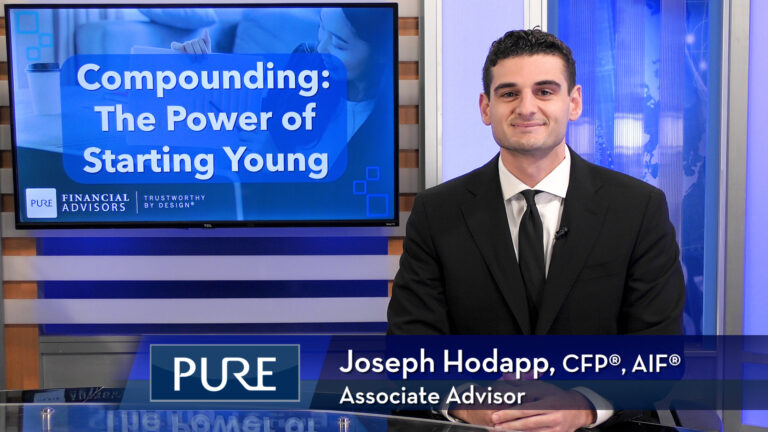Are you prepared with your year-end financial checklist to make the most of the new tax laws as 2025 comes to a close? Pure’s Director of Tax, Amanda Cook, CPA, CFP®, shares key updates and practical tips to help you stay ahead in your 2026 tax planning.
Transcript
It’s hard to believe that 2025 is coming to a close! Here are some updates and tips to help you with your year-end financial to-do list.
First, the Tax Sunset
In 2017, Congress passed the Tax Cuts and Jobs Act (called TCJA), after the One Big Beautiful Bill Act (or OBBBA) passed this year, the tax brackets were made permanent, meaning there is no expiration date set for them. Additionally, the increased standard deduction was increased a little more and also made permanent.
But that doesn’t mean you won’t be itemizing this year
Now, for those with Modified Adjusted Gross Income (called MAGI) up to $500,000, the deduction is $40,000 except if you’re Married Filing Jointly (then it’s half these numbers). People in high tax states who were previously limited by the $10,000 cap may now be itemizing or close to it, which creates more planning opportunities like bunching deductions into certain tax years.
High itemized deductions can offset high income.
Because tax rates increase as your income increases, deductions are at their most valuable in your highest income years. In a year when you have higher than normal income, it may make sense to try to bunch your deductions into that year. For example, in CA, where I am, property tax is paid in two installments; you can pay 3 installments in a single tax year to increase your deduction. Complete your out-of-pocket medical expenses, like dental work and new glasses in a single year. For charitable contributions, a Donor Advised Fund can allow you to take a large charitable deduction in one year while still contributing according to your regular cadence.
Conversely, sometimes you have high deductions in a certain year already. You can increase your income with, for example, a Roth conversion to utilize those deductions.
But Beware of MAGI!
Deductions reduce taxable income so it will lower your tax, but deductions come after MAGI is calculated. A number of items are triggered by high MAGI. Net investment income tax, Medicare Premiums, and the new Senior Deductions are a few examples. As a result, a Roth conversion of $20,000 may not be fully offset by a charitable contribution of $20,000 due to changes in MAGI.
The New Senior Deduction
This is a new feature of the OBBBA, which is a deduction of up to $6,000 per person, depending on MAGI and filing status. This deduction is available to individuals who are at least 65 at the end of the tax year. There has been some confusion during the year about whether or not Social Security taxed has been changed. It hasn’t! Social Security is taxed the exact same way it has been for decades, but many people who receive Social Security income will also receive this deduction. People who are age 65 and older and not yet collecting Social Security income will also receive this deduction, however, and people who are under age 65 and are receiving Social Security income will not receive this deduction. Also, this deduction affects taxable income but does not reduce MAGI. You aren’t required to itemize to claim it, though.
This is part of a new category of deductions
It includes the new deductions for overtime pay and also tips; these will not be deducted “off the top” of your pay. Instead, they will be included in your pay and counted for MAGI but will reduce taxable income even if you don’t itemize deductions.
These changes were passed retroactively for 2025 and they expire!
Therefore, if you qualify for any of these new breaks, it’s a good idea to learn how you can take advantage of them as soon as possible so you can preserve your tax benefit for 2025 or set yourself to qualify in 2026! Take advantage of our free tax assessment to see how to leverage these new tax rules to benefit you.
Subscribe to our YouTube channel.
IMPORTANT DISCLOSURES:
• Investment Advisory and Financial Planning Services are offered through Pure Financial Advisors, LLC, a Registered Investment Advisor.
• Pure Financial Advisors LLC does not offer tax or legal advice. Consult with your tax advisor or attorney regarding specific situations.
• Opinions expressed are subject to change without notice and are not intended as investment advice or to predict future performance.
• Investing involves risk including the potential loss of principal. No investment strategy can guarantee a profit or protect against loss in periods of declining values.
• All information is believed to be from reliable sources; however, we make no representation as to its completeness or accuracy.
• Intended for educational purposes only and are not intended as individualized advice or a guarantee that you will achieve a desired result. Before implementing any strategies discussed you should consult your tax and financial advisors.
CFP® – The CERTIFIED FINANCIAL PLANNER® certification is by the CFP Board of Standards, Inc. To attain the right to use the CFP® mark, an individual must satisfactorily fulfill education, experience and ethics requirements as well as pass a comprehensive exam. 30 hours of continuing education is required every 2 years to maintain the certification.
CPA – Certified Public Accountant is a license set by the American Institute of Certified Public Accountants and administered by the National Association of State Boards of Accountancy. Eligibility to sit for the Uniform CPA Exam is determined by individual State Boards of Accountancy. Typically, the requirement is a U.S. bachelor’s degree which includes a minimum number of qualifying credit hours in accounting and business administration with an additional one-year study. All CPA candidates must pass the Uniform CPA Examination to qualify for a CPA certificate and license (i.e., permit to practice) to practice public accounting. CPAs are required to take continuing education courses to renew their license, and most states require CPAs to complete an ethics course during every renewal period.












